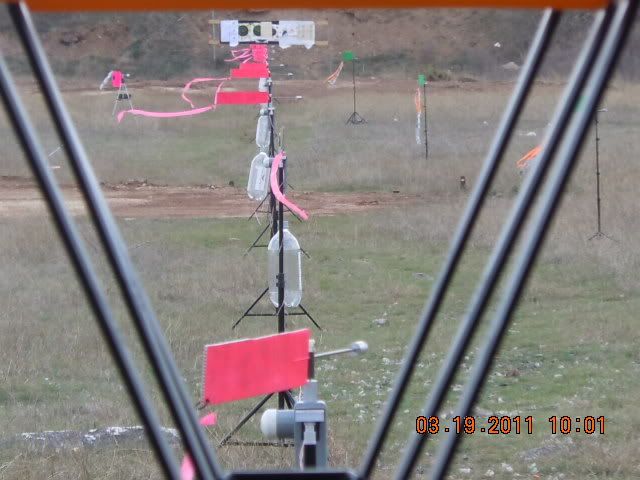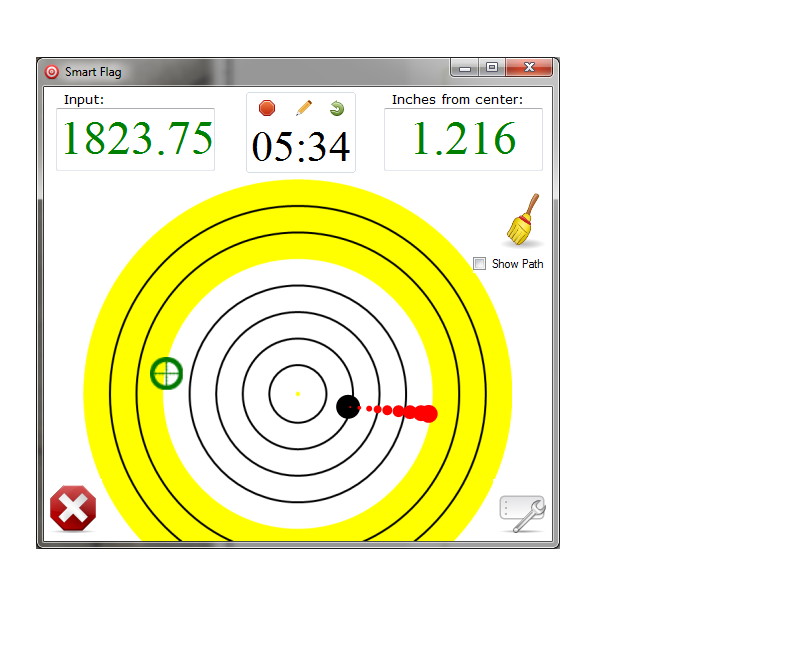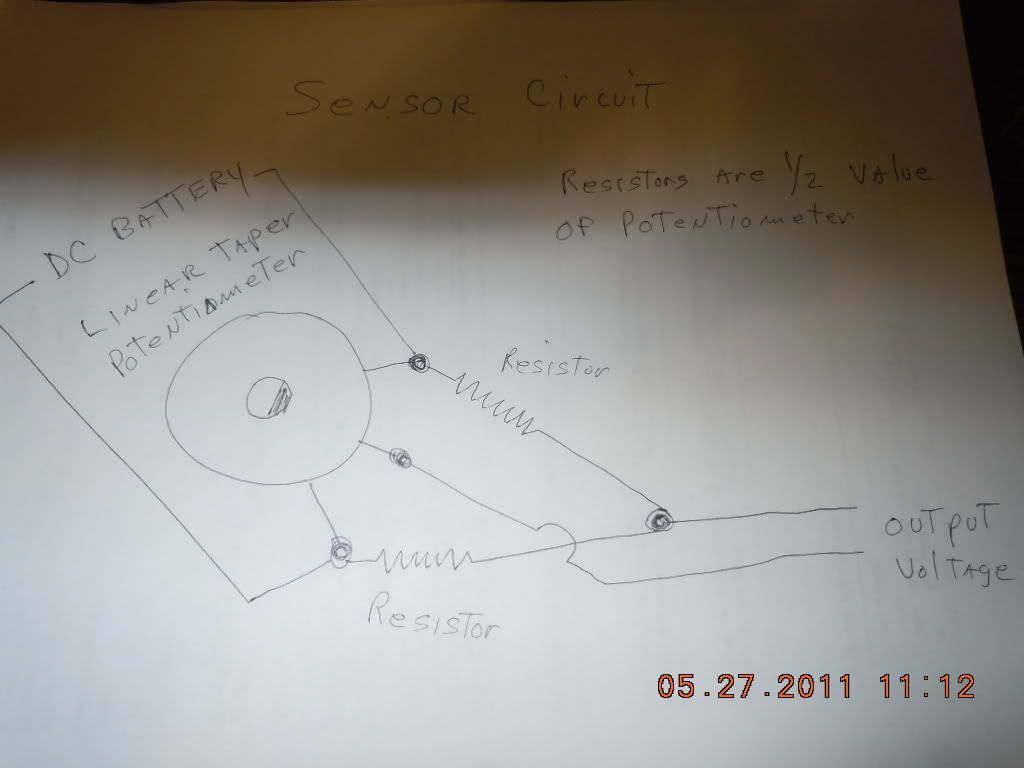You are using an out of date browser. It may not display this or other websites correctly.
You should upgrade or use an alternative browser.
You should upgrade or use an alternative browser.
Wind flags
- Thread starter j3x44
- Start date
Vern
Morethan1waytoskinacat
On a secondary note. Last week I was doing some testing on my wind flags that use opposing magnets.
I put them in front of a round fan to see if they were reacting properly.
I became confused because they started acting like all the flags at a range. From a dead on head wind they would turn straight in then bounce back and forth and read the same then read opposite of each other side by side. Then the same running behind.
I thought about it for awhile and thought about the Dyson commercial and we have a couple of central air type squirrel cage fans in the shop.
I set them up in front of that and low and behold they held straight on no moving.
SOOOOOO the circular fan creates something similar to what is at the range and the other is just a straight dead wind.
For what its worth
I put them in front of a round fan to see if they were reacting properly.
I became confused because they started acting like all the flags at a range. From a dead on head wind they would turn straight in then bounce back and forth and read the same then read opposite of each other side by side. Then the same running behind.
I thought about it for awhile and thought about the Dyson commercial and we have a couple of central air type squirrel cage fans in the shop.
I set them up in front of that and low and behold they held straight on no moving.
SOOOOOO the circular fan creates something similar to what is at the range and the other is just a straight dead wind.
For what its worth
Jerry H
Different Drummer
This won't change anything. Walter Watts did this 40+ years ago! First and foremost it takes a great shooting gun each and every target to win. Unfortunately the masses believe that they are not winning because of some other reason. I over held, I under held, the bullet went against the condition, that shot jumped up, the last shot fell out the bottom, slapped the trigger, shouldered the gun, my front rest is loose, my scope is no good, bad bullets, no magic powder, I don't have a hummer barrel and on and on. You would be amazed how well you can suddenly read conditions with a great shooting gun. With this system you will lose a lot of excuses for poor performance. Anyone can build their own, as the design is very simple. A potentiometer, 2 resistors, a DC voltage source, speaker wire and a digital voltmeter will do it. Construct the sensor based on a Wheatstone Bridge electronic circuit. Set the excitation voltage at each as you think the weighting should be. Wire the outputs together in series and read the total voltage to determine the winds net effect at the target.
Jerry H
Different Drummer
If this was the threat that many mistakingly believe it is, I would have won every match that I entered for the last ten years! Not even close. Is it a superior wind sensing system? Absolutely in anything but mild conditions as it needs 3mph true wind speed to function reliably. It is just another type of wind flag that may or may not be suitable for a particular individual or types of wind.
Vern
Morethan1waytoskinacat
Jerry.... I knew you would show up.
I dont think its a threat but pure genius.
It will some day put a stop to all of those lying wind flags.
And thus the reason I referred to if the gun is in tune a 10 year old could shoot.
You missed the last match. I think I finally got it together. My flags worked good but not as good as yours. Some day if you are still making them I WILL have a set.
We still need great innovators in this sport not afraid to embrace new ideas and change. Tinkerers.
I do hope some day I can put mine on the firing line and execute the little P(*Y(*&T&*^ guys.
I dont think its a threat but pure genius.
It will some day put a stop to all of those lying wind flags.
And thus the reason I referred to if the gun is in tune a 10 year old could shoot.
You missed the last match. I think I finally got it together. My flags worked good but not as good as yours. Some day if you are still making them I WILL have a set.
We still need great innovators in this sport not afraid to embrace new ideas and change. Tinkerers.
I do hope some day I can put mine on the firing line and execute the little P(*Y(*&T&*^ guys.
Jerry H
Different Drummer
Vern, since I have finished with developing the SmartFlag, I moved on to my next project. Since the SmartFlag uses a net book, not an expensive laptop as you stated, I am playing with a wireless surveillance camera to see my shots at 200 when the mirage makes the bullet holes invisible. It looks promising so far.
M
mks
Guest
Unfortunately it won't be that easy. Still need a lot of human interface to decipher what the wind is telling you.
I agree with regard to Jerry's/Walter's system. But if electronic "flags" are legal, then it is entirely possible to build a system with which the only human interface needed is to shoot where the computer tells you to. Here's the system: three-axis hot wire probes (~10 kHz frequency response, a thousand times faster than analog flags, even Ezell's), placed at intervals as short as your pockets are deep, measuring all three components of wind velocity, fed into an external ballistics computer that calculates wind deflection for your particular bullet, load and atmospheric conditions. Temperature and relative humidity inputs to the computer, too, to make the ballistic calculation more exact. The display in the scope has two reticles, one stationary that you initially designate with a button as being where you want to hit the target, the other floating computer-generated reticle describes your aiming point to compensate for the wind. The computer program could even learn the wind patterns at particular ranges and warn you when a switch is occurring or is likely to occur. The algorithms could be adaptive so that the more you use the system, the more accurate it gets.
If I shot NBRSA, I would start working on this system tomorrow. Jerry, if we lived closer together, we could develop this together. Y'all know reading the wind is key to winning. This system would beat Tony Boyer, like Deep Blue beat Garry Kasparov and Watson beat Ken Jennings. But then the board would outlaw it, like happened with Jim Hall's Chaparral sucker car, it would be so dominating. It would be fun while it lasted.
Dreaming,
Keith
Jerry H
Different Drummer
MKS, you might want to read post 23. Wind reading is a distant second in comparison to how the rifle is performing at any given moment. I already explored a 2 axis system and it proved to be of no additional value. I did look into a hot wire sensor several years ago and deemed it impractical. Certainly with enough money anything might be attempted. As Nike says, just do it. Lets compare notes afterward. Benchrest has always been about the most accurate gun first, all the rest is secondary. Shoot this game for 25+ years and you will come to that understanding.
Lawrence W.
Member
The problem is still that the computer is telling you what the wind just did. It is the human interface that is required to predict what the wind will be doing when you pull the trigger.
My favorite quote is that of Jackie Schmidt watching Jerry Hensler shoot over his system. "If Jerry could keep his gun in tune we would all be in trouble. At 200 yards, his groups are .200 wide and .800 tall!"
My favorite quote is that of Jackie Schmidt watching Jerry Hensler shoot over his system. "If Jerry could keep his gun in tune we would all be in trouble. At 200 yards, his groups are .200 wide and .800 tall!"
Vern
Morethan1waytoskinacat
Ok for all the skeptics out there. There is as JERRY has said the tune of the gun being the most important.
I have shot over his system and it is far more than he will admit at least in my opinion.
As Jerry once said there are 3 catagories of shooter and I dont think I can accurately quote him but it amounts to this.
Those who just enjoy the fellowship, those who want to find new tech and info so to say explorers, and those who only care about the competition.
I am sure Jerry will correct my mis-statements shortly but .......
Those who are true innovators of the sport are who we truely have to be thankful for in the changes we have since the early days. If you dont believe me read some of the books from the 70s-80s and see how far we have come
I have shot over his system and it is far more than he will admit at least in my opinion.
As Jerry once said there are 3 catagories of shooter and I dont think I can accurately quote him but it amounts to this.
Those who just enjoy the fellowship, those who want to find new tech and info so to say explorers, and those who only care about the competition.
I am sure Jerry will correct my mis-statements shortly but .......
Those who are true innovators of the sport are who we truely have to be thankful for in the changes we have since the early days. If you dont believe me read some of the books from the 70s-80s and see how far we have come
M
mks
Guest
MKS, you might want to read post 23. Wind reading is a distant second in comparison to how the rifle is performing at any given moment. I already explored a 2 axis system and it proved to be of no additional value. I did look into a hot wire sensor several years ago and deemed it impractical. Certainly with enough money anything might be attempted. As Nike says, just do it. Lets compare notes afterward. Benchrest has always been about the most accurate gun first, all the rest is secondary. Shoot this game for 25+ years and you will come to that understanding.
Jerry,
Absolutely, the gun must be in tune first, then wind reading is huge compared to everything else. I mentioned three-axis to show what could be done, not what one would choose when all criteria, including cost and convenience, are taken into consideration. I am actually surprised that you found no additional value in the second axis. One of the most difficult conditions I have shot in was a strong head/tailwind that shifted a little in the crosswind direction. It caused significant horizontal and vertical deflection that could not be predicted with a crosswind sensor alone.
I would be all over this if I shot NBRSA, but I'm not going to bother for a system that is illegal for what I shoot. The possibilities have me excited, though.
Cheers,
Keith
M
mks
Guest
The problem is still that the computer is telling you what the wind just did. It is the human interface that is required to predict what the wind will be doing when you pull the trigger.
My favorite quote is that of Jackie Schmidt watching Jerry Hensler shoot over his system. "If Jerry could keep his gun in tune we would all be in trouble. At 200 yards, his groups are .200 wide and .800 tall!"
The computer can also tell you what it thinks will happen, based on historical and recent patterns. The display could go from green to red based on the rate of wind velocity change, i.e. the likelihood and strength of a switch. This is a good example of a task that a computer can do better than a human.
The fact that Jerry can keep horizontal out of his groups with his current system is evidence of the potential of such a computerized system.
Jerry H
Different Drummer
Another picture with system piggybacked with traditional flags.

This system is designed to augment traditional flags, not replace them. Also to provide a safety net so to speak for very rough conditions. The strain guage system utilizing a string to catch the wind is a true replacement for tradional flags and has the greatest potential for maximum accuracy. The pendulum/probe system is probably limited to +/- .1MOA at best.

This system is designed to augment traditional flags, not replace them. Also to provide a safety net so to speak for very rough conditions. The strain guage system utilizing a string to catch the wind is a true replacement for tradional flags and has the greatest potential for maximum accuracy. The pendulum/probe system is probably limited to +/- .1MOA at best.
Last edited:
Boyd Allen
Active member
One of the repeating themes in wind flag discussions is the question of where the wind has the most influence on a bullet's flight. The reason that I bring this up is that in order for Jerry's electronic flags to give reliable results, he had to solve this problem, and assign a number to the influence that each flag would have on the total reading. I had to smile when I read his comment that his flags were only good to +- .1moa. Who among us would claim to be able to read strong, variable winds to that level of precision? In any case, I think that his work is fascinating, but if his flags start to dominate, how will that change the sport? Evidently, we are about to find out. Kudos to a great innovator.
Jerry H
Different Drummer
The change would probably improve the overall average score for everyone but have no influence on the rankings. The real improvement would come from the ablility to work out other problems in less than ideal conditions. Then again maybe not due to the optical refraction caused by conditions. DARPA is funding laser condition reading scopes that could read both wind and refraction induced shot displacements. I don't see that working in anything but light winds though.




